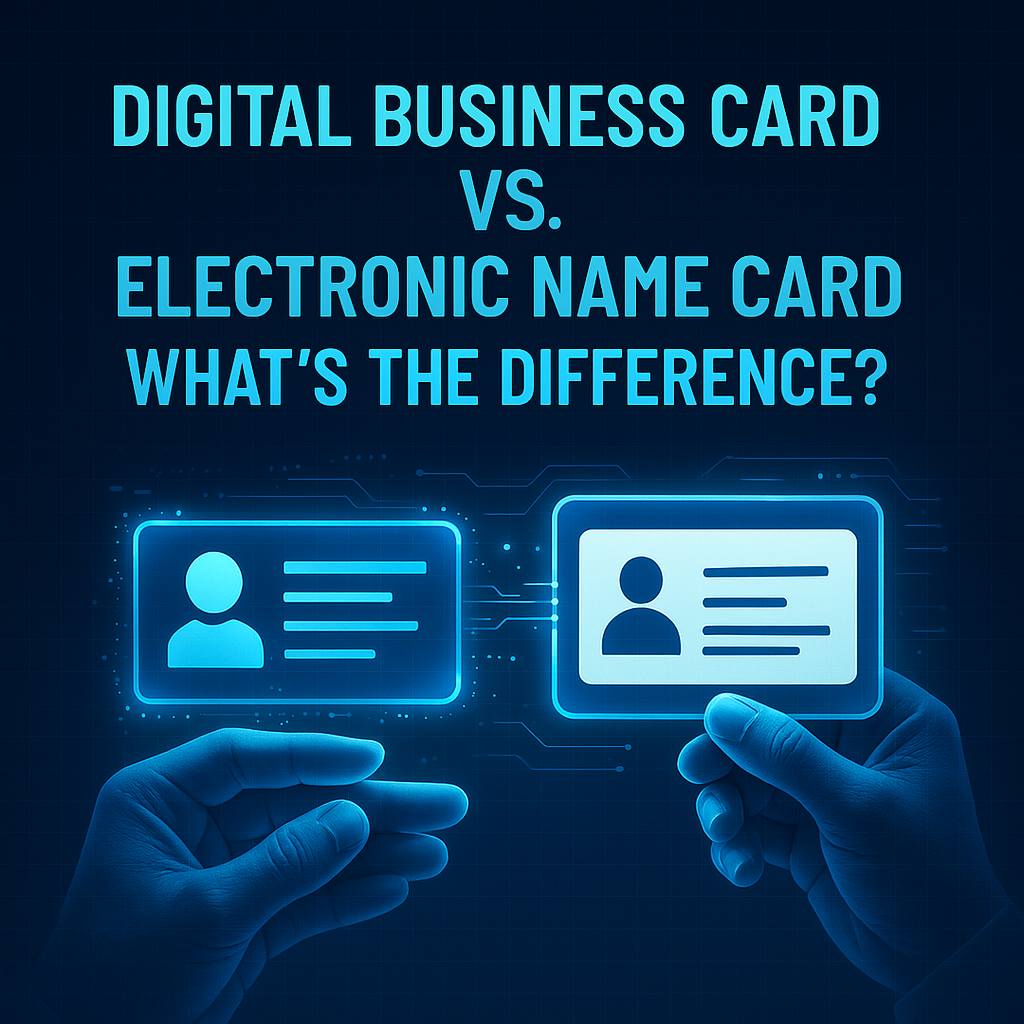
In today’s fast-moving work world, staying connected matters more than ever. Professionals now swap contact details with a few taps instead of printed cards. One popular tool is the digital business card, often used during meetings or events. While it seems similar to an electronic name card, the two offer distinct uses. Understanding the gap between them helps workers and firms choose the right one.
This blog breaks down what each card offers, how they work, and where they shine.
What Is a Digital Business Card?
- A digital business card instantly shares your contact details online. It shows your name, job, phone number, email, website, and links to social pages. You can send it by text, email, QR code, or let someone scan it with a phone. These cards replace paper ones, cut waste, and let you update details quickly.
- Unlike paper cards, digital ones let people tap, call, or explore your links straight from the screen. This quick access makes it a smart choice for busy jobs where fast connections matter.
What Is an Electronic Name Card?
- An Electronic Name Card also holds your contact information. It shows up in email footers, digital ID systems, or work apps. You find them mostly in offices, government places, or schools. These cards help others officially recognise you and add a professional touch.
- Both tools store contact details, but they work differently. Electronic name cards fit best in workplaces where security and formal systems matter most.
Key Differences Between the Two
Let’s look at how they stand apart.
Digital Business Card vs. Electronic Name Card
| Feature | Digital Business Card | Electronic Name Card |
| Use | Networking, sales, events | Office use, ID systems, emails |
| Sharing Method | QR code, link, mobile app | Email footer, company directory |
| Customisation | High (colours, logo, video) | Low (fixed by company or format) |
| Update Speed | Instant (cloud-based changes) | Slower (needs IT or admin changes) |
| Contact Methods | Social links, maps, direct call | Basic info only |
| Flexibility | Works across industries and roles | Stays within one organisation |
Who Should Use a Digital Business Card?
- A digital business card works best when you meet new people often. It boosts sales teams, freelancers, event hosts, and even students by helping them stay connected. You can shape the card to match your brand, style, or personality.
- Since the card links to websites, portfolios, or social profiles, it fits creative jobs too. Artists, writers, designers, and marketers showcase their work without printing hard copies. Business owners also share them with clients for instant access to services.
When to Choose an Electronic Name Card?
- If you work in an office or secure space, an Electronic Name Card suits you better. It attaches your name to your role and guides coworkers in the same system to find you quickly. These cards follow set rules to keep the company’s look and feel the same.
- Internal teams use them to send updates, reserve meeting rooms, assign tasks, or log in to systems. Since they connect with office software, they act more like IDs than promo tools.
Which One Helps You Network Better?
- Networking means meeting new people and forming strong connections. A digital business card makes that easier. You send it to anyone, anywhere, with a quick tap. People don’t misplace it or throw it away. With one scan or click, your new contact saves your info instantly.
- You also update it easily. Starting a new job? Adding a fresh link? Just edit once, and all new viewers see the updated card right away.
How Safe Are They?
Some people fear privacy risks. Both kinds of cards hold data, so handling them with care matters.
- Digital business cards lock details with special codes to protect links. Users choose what to show and what to hide. Some apps even let you switch off the card if needed. Others shield it with passwords or limit who can peek at the details.
- Electronic name cards stay tucked inside office systems. They don’t wander outside unless the user copies the info. That adds a layer of safety but also keeps them less open for networking. Some companies even place extra gates like login screens to guard access.
Style and Look
- Digital cards unleash creativity. You paint them with bold colours, snap in a photo, or even drop in a video. This spark helps you shine and stick in people’s minds.
- Electronic name cards follow strict layouts. Their tidy design fits formal jobs, but they leave little room for personal flair. While they show professionalism, they can’t capture your unique style the way digital ones do.
Pros and Cons
Here are the Pros And Cons of Digital Business Card and Electronic Card
| Card Type | Pros | Cons |
| Digital Business Card | Easy to share, flexible, looks sharp | Needs internet access, can seem too casual |
| Electronic Name Card | Formal, safe, and great for office systems | Hard to share outside, limited features |
Can You Use Both?
- Yes, many people do. You might flash your electronic name card inside the office while tapping a digital business card at meetings, events, or networking sessions. Both work in different ways and make sharing easy. The trick is to know when and where to use each one.
- For example, a teacher hands out an electronic name card at school to reach students and parents. But at workshops, conferences, or training events, they pull up a digital card to connect with new people.
Why Does Choice Matters?
- Picking the right tool helps you link up with others the best way. A bad choice may confuse, slow down a chat, or feel unprofessional. If you meet new people often, stick with a digital card for quick and easy sharing. If you stay in one place most of the time, an electronic name card keeps things simple.
- The way you share your info tells a story. A smooth, easy tool builds trust, sparks interest, and leaves a mark.
What to Put on Your Card?
No matter which card you pick, fill it with these details so people remember you fast:
- Your full name (so they know who you are)
- Job title (what you do best)
- Company name (if needed)
- Phone number (for quick calls)
- Email (for easy messages)
- Website or profile (to show off your work)
- Social links (if they help your job)
- Photo (optional, but makes you easy to spot)
- Tagline or short bio (a few words that describe you)
- QR code (for a fast scan of your details)
Final Thoughts
The digital shift unlocks fresh ways to connect. A digital business card flashes your details fast and with style. It slides into today’s mobile world, making networking smooth and effortless.
On the other hand, an Electronic Name Card stands firm in formal spaces. It acts as an official ID in digital systems and helps coworkers spot your role instantly.
Both cards serve their purpose. The key rests in choosing the right one at the right time.
Whether you aim to wow a new client, trade details at an event, or just scribble your name on an office form, there’s a card for that.




